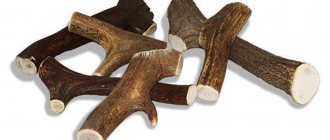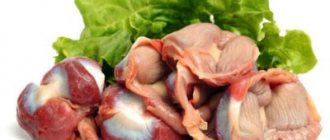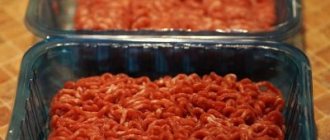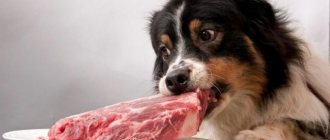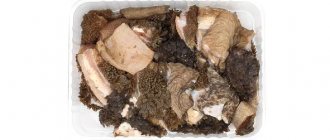Dogs are predators, so their diet should be tailored to their body structure. In particular, most of the diet should be meat, but even good beef does not contain all the microelements necessary for a full life.
So that the dog does not need anything and does not switch to artificially created supplements, you can add liver to the menu. This by-product is one of the most useful, as it contains a number of vitamins, amino acids and microelements, in particular iron, which affects the production of red blood cells.
Before introducing a new ingredient into your puppy’s diet, you should decide whose liver is most useful and in what form it is best to give it: fresh or cooked.
Advantages and disadvantages
The liver brings many benefits to the body of pets.
With its regular use, the immune system is strengthened, toxins are eliminated, and the active formation of new cells begins.
What substances does it contain?
The product contains many substances necessary for the body, including vitamins D, E, PP, K, C and A. It also contains:
copper;- magnesium;
- potassium;
- fluorine;
- iron.
The liver contains many amino acids necessary for the full functioning of the dog’s body.
Is offal given to puppies?
Liver can be given to puppies, but in small quantities. This product is also not contraindicated during pregnancy and lactation.
Benefits and harms for older animals
You can give offal to dogs in old age, but with the utmost caution. The extractive components it contains can be harmful.
Therefore, you should include it in the menu no more than 2 times a week. One serving is only 50 g.
How to give?
Veterinarians believe that liver is only good in small quantities and should not be used as the main or sole source of protein. The optimal solution is if this product is used as a treat to diversify the diet.
It is preferable to give small portions of liver boiled.
For large breed dogs (Alabai, Bernese Mountain Dog, Weimaraner), a dose of up to 100 grams is acceptable. 2-3 times a week.
Small breeds such as Yorkshire Terrier, Chihuahua, Dachshund or Spitz should be given approximately 50 grams. 1-2 times a week.
Important. It is necessary to include liver products in your pet’s diet gradually and in moderation, starting with just a few grams. After the first dose, you should take a break of several days (1-2 days), and then again give a portion slightly larger than the first.
If a dog is accustomed to dry food, then at first it may not be willing to accept liver. But this is a temporary phenomenon. Most breeders note that tailed animals eat beef liver with great pleasure and should not be excluded from the diet if the pet once refuses.
Raw or cooked?
Some breeders provide this offal in raw form. Are they doing the right thing? There is no definite answer to this question, since much depends on the individual characteristics of the animal, its lifestyle and other factors.
Reference. Raw liver acts as a laxative. Boiled liver has a slight strengthening effect.
Veterinarians say that modern dogs are so domesticated, and their diet is as close as possible to that of a human, that it is not worth the risk of giving a raw food. Of course, not a single dog will refuse a piece of raw meat or offal, but this can lead to dire consequences (diarrhea, ascariasis, etc.).
Not a single seller in a butcher shop will give a 100% guarantee that there are no parasite eggs or high levels of hormones in the liver. Don't take risks and boil the liver before eating. It doesn’t take long to prepare, so it doesn’t have time to lose its beneficial properties.
When liver is a prohibited product for a dog
Despite the enormous benefits of the offal, there are a number of contraindications for its use as dog food.
For example, if your pet has high cholesterol levels, it is worth discussing the advisability of including liver in the diet with your veterinarian. It contains its own cholesterol, which can be deposited in blood vessels.
Also, this product should be discarded if the animal has problems with the heart and blood vessels. For such health problems, it is allowed to give the animal only small portions.
Also, caution should be exercised when introducing liver into the menu if there is a disturbance in the gastrointestinal tract. Against the background of its use, the situation may worsen, causing diarrhea or constipation.
General Facts About Eating Raw Liver
According to the USDA, 30 grams of chicken liver contains the following:
Note : These figures refer to the liver of industrially bred chickens. We'll talk more about this in a minute, but the quality of the liver you feed is very important. These numbers are higher in pasture-raised animals.
- 2 grams fat
- 6 mcg vitamin B12
- 4076 IU vitamin A
- 162 mcg folic acid
- 6 milligrams vitamin B2 (riboflavin)
- 23 milligrams selenium
- 9 milligrams vitamin B5
- 6 milligrams iron
- 9 milligrams vitamin B3/niacin
- 2 milligrams vitamin B6
- 125 milligrams phosphorus
Which is better: raw or boiled
Often dog breeders decide to give their pets raw liver. The dog will happily eat such an offal.
But after this she may experience diarrhea, and there is a risk of helminth infection: their eggs are often contained in the offal.
Therefore, it is better to boil the treat and only then give it to your pet. The heat treatment is short and maximum benefits are retained.
Is it possible to feed liver to puppies?
Chicken by-product is very beneficial for puppies. This is explained by the fact that it contains many vitamins that have a beneficial effect on the formation of the nervous system and the entire body as a whole.
Liver can be given from 2 months, introduced into the diet gradually. Initially, it is recommended to use it as complementary food, giving the puppy several pieces of treats per week.
If you include the product in the food more often, the baby may develop bone deformation or an allergic reaction, the symptoms of which are as follows:
- Severe itching of the skin.
- Rash all over the skin.
- Discharge from the eyes.
- Increased tear production.
- Discharge from the nasal cavity.
- Swelling of the muzzle.
- Unpleasant odor from the animal.
- Ear pain.
- Diarrhea and other gastrointestinal disorders.
Allergies always manifest themselves with clear symptoms, but do not occur in all animals. Therefore, before feeding your dog liver, you should conduct a test: give it a small amount of the product and see how the body reacts.
Choosing a quality product
It is extremely important to choose a liver responsibly so as not to harm your pet.
Several important nuances deserve attention.
Color
The offal should have a red-brown tint. It is unacceptable to have any stains on it. The liver's blood is scarlet. If it is dark, then the product is clearly stale.
Smell
Normally, the product emits a sweetish aroma. A slight smell of ammonia indicates its staleness.
Fresh or frozen
You can find both fresh and frozen products on sale. The second option, as a rule, is cheaper than the first, but it contains significantly fewer useful elements.
Therefore, it is recommended to give preference to fresh liver.
Which liver is the best?
The livers of different animals have slightly different properties, but for the most part, the livers of different animals provide similar nutritional benefits.
Below are the different types of liver you can find in grocery stores, farmers' markets, local butcher shops, or even online:
- Chicken Liver – Chicken liver has the mildest flavor, making it a good snack. Chicken liver has more fat, folic acid and iron than beef liver.
- Beef Liver – Compared to chicken liver, beef liver contains slightly more vitamin B12, vitamin B6, vitamin A, zinc and phosphorus.
- Fish Liver – Fish liver (even better, whole fish) is an excellent source of omega-3 fatty acids, vitamin A and vitamin D.
You can also feed lamb, mutton, goat, duck, turkey, goose liver, rabbit liver, etc.
Proper processing
The offal must not only be selected correctly, but also processed. In this case, you should follow a number of simple recommendations.
In what form should I give it to my dog?
Before cooking, the liver must be cleaned of veins, washed and kept in cold water for about half an hour.
Then it is boiled. You can also add vegetables if desired. Due to this, the offal will be tastier.
You can not only cook the liver, but also stew it. You shouldn't fry it for dogs. With such heat treatment, it will become hard, dry, lose a large number of beneficial properties, and cholesterol levels will increase.
Recipes for pets
There are many recipes for preparing delicious treats.
You can make pate for your animal. You will need:
- liver – 200 g:
- cream – 1 tbsp;
- sunflower oil – 1 tsp.
The offal is cut into pieces and stewed over low heat in oil. After a quarter of an hour, cream is added to the container, everything is crushed using a blender.
The resulting pate can be added to other dishes. You can form it into balls that your dog will eat with pleasure.
Recommended by-products
Now let's take a closer look at what by-products can be given to a dog, and what benefits they bring to the animal's body. I will not describe in detail all the beneficial properties of tripe. Quite a lot has been written about this. I would just like to note that almost all offal is saturated with valuable microelements, the content of which in muscle meat is an order of magnitude lower.
Heart
In its structure, the heart is most similar to muscle meat. However, it is much denser and heavier than the first, and it contains twice as much collagen, elastin and protein.
The heart is given both boiled and raw. You can include beef, pork, lamb or chicken hearts in your pet's diet (if you are not allergic to chicken products).
Scar
The rumen is the most valuable part of the herbivore's stomach, rich in protein, enzymes and beneficial bacteria that help digest plant foods. Enzymes neutralize and remove toxins from the blood, strengthen the immune system and generally support the functioning of the barbosik’s gastrointestinal tract.
But, despite the specific smell, to put it mildly, it is the unpeeled raw tripe that is most valued.
Although some four-legged owners find the smell of tripe disgusting, almost all dogs simply fall into ecstasy from this offal and adore dishes made from tripe.
Kidneys
The kidneys contain vitamin D and a huge amount of fatty acids, which have a beneficial effect on the condition of the skin and coat of the four-legged animal.
Kidneys can be fed either raw or boiled. But, before giving the dog raw offal, it is recommended to soak the kidneys in cool water for about 30 minutes.
Liver
The liver acts as a kind of filter through which toxins enter the body.
The amount of liver should not exceed more than 5% of the pet’s total meat diet. But these numbers have nothing to do with the filtering function. All passing toxins do not settle in the liver, but are successfully neutralized.
The percentage of recommended dosage is due to the fact that the liver contains a huge amount of fat-soluble vitamin A, which can trigger the formation of stones. In addition, an excess of the product can lead to digestive upset.
Liver is rich in iron, folic acid, vitamins A, B and D:
- Iron improves blood composition, maintains hemoglobin and sugar levels.
- Vitamin A has a positive effect on reproductive functions.
- Folic acid, vitamins B and D strengthen the nervous and cardiovascular systems.
Liver is most beneficial for growing puppies and lactating bitches. It can be given to dogs either boiled or raw. Raw liver contains much more nutrients. However, if your pet is on a raw food diet, in order to avoid infection with helminth larvae, which are sometimes found in the liver, it is better to buy the product from a trusted manufacturer and freeze it for at least three days before feeding it.
Spleen
The structure of the spleen is something between muscle meat and liver. Like the liver, the spleen is rich in protein, iron and amino acids.
But, just as in the case of liver, it is advisable to feed your pet with it in limited quantities and in boiled form. Excessive amounts of this by-product can lead to loose, black stools.
Lung
Lung is a rather controversial by-product. There are not as many benefits in it as from any other tripe. There is little useful protein in the lung. But there are plenty of connective fibers in it, as a result of which the product is poorly absorbed.
You cannot feed your dog this by-product alone. This can lead to permanent gastrointestinal disorders.
But this type of offal should not be completely excluded. The lung is rich in microelements that improve the functioning of the brain, heart and blood vessels. In addition, light is a low-calorie dietary product.
It is better to introduce lung into a dog’s diet in boiled form and in combination with other meat ingredients. But a natural treat for dogs, made from light, will greatly please your pet and is perfect as a reward during training.
Udder
Just like the lung, the beef udder contains a lot of connective fibers. The udder is quite fat. Therefore, to avoid loose stools, the amount of product in the diet must be controlled.
The udder is rich in vitamins that help increase endurance and intensively build muscle mass. The milk udder is especially useful. It has less fat.
It is recommended to give udder to pregnant dogs and puppies from the age of three months, in strictly limited quantities, after removing excess fat. The udder is well digestible and helps to gain weight too quickly, which can be dangerous for a growing body.
Bovine testes
Testes are considered a canine delicacy. Bovine and lamb testes are useful for puppies, as they contain magnesium, iodine, potassium, calcium and other valuable mineral components. Testes are an excellent source of hormones and easily digestible protein, and are recommended for feeding to male dogs before mating.
If mating is not planned, this by-product should be given to male dogs with caution. Too much can cause overstimulation.
Beef brains
Like most organ meats, brains are extremely beneficial for dogs. However, they should be consumed no more than once a week.
Despite its low calorie content, brains are not a dietary product. They are rich in heavy fats and cholesterol, which are poorly absorbed by the tailed body, but allow you to feed the four-legged heartily. Beef brains are included in the diet of weakened animals during the recovery period after illness or surgery.
Beef tongue
The composition of beef tongue is similar to the spleen. This is a good, but quite expensive offal for dogs. But, you can easily pamper your beloved pet with this delicious meat. The tongue can be given either boiled or raw.
Beef cheeks
Beef cheeks belong to the first category by-products. Cheeks are recommended for consumption due to their high content of iron, magnesium, manganese and copper, which are not found in all offal. Complete proteins and the absence of connective tissue make the cheeks easily digestible.
In terms of nutritional value, beef cheeks are not inferior to meat. They can be fed to dogs either raw or boiled as a main dish.
Beef trimmings
Beef trimmings are much cheaper, but can be used for feeding four-legged animals along with muscle meat. Meat trimmings contain tendons, cartilage and veins. Due to this, the trimmings are considered healthier than the finest cuts of meat.
Veins and cartilage are an excellent natural source of gelatin, useful for strengthening bones and joints. Good meat trimmings contain about 10% cartilage tissue and 90% pure meat.
Ears, nose, lips and tails
Ears, lips and tails are not suitable for inclusion in a nutritious diet. They have little protein, but they have plenty of calcium, phosphorus, elastin and collagen.
These by-products are perfect as a treat. They can be given boiled, raw or dried in the oven. Such treats perfectly clean plaque and train the jaw apparatus, and will also keep your pet occupied while you are away.
Beef cartilage by-products
Cartilaginous by-products include such offal as: caltyk, trachea, epiglottic cartilage and diaphragm.
Beef kaltyk and trachea are especially popular among both dog breeders and their four-legged friends. They are similar to each other in their nutritional value. But kaltyk has more meat.
Cartilage is rich in calcium, elastin and collagen, which are so beneficial for the bones and joints of the four-legged animal. Nutrients strengthen the walls of blood vessels and capillaries and participate in the regulation of water-salt metabolism.
Cartilaginous by-products are suitable both for raw feeding and for preparing treats and treats for dogs. But they should be given in limited quantities for the reason that the mucus contained inside the cartilage in excess can cause digestive upset.
Poultry by-products
In the absence of allergies and individual intolerances, bird by-products will be an excellent addition to the four-legged diet. Read more about the benefits of poultry by-products.
Dry food with liver
The by-product is often added to industrial feeds. They have their pros and cons.
Advantages
Among the advantages of feed, the following qualities should be highlighted:
there is no need to prepare food for your pet, just measure the required amount and pour it into a bowl;- the daily norm is indicated on the packaging; there is no need to independently calculate the optimal portion size;
- balanced food saturates the pet’s body with all useful substances;
- the cost is lower than that of natural products.
Flaws
This type of feeding also has disadvantages:
it is impossible to reliably know what is included in the product;- high risk of allergies due to incorrect choice of food;
- a low-quality product can lead to health problems.
In feed
In addition to homemade dishes, today you can easily find ready-made dog food that contains beef liver (most often it is wet food, for example Delipet, SOLID NATURA, Terra Dog).
This option has a number of advantages:
- saving time and effort (no need to cook, just put the required amount in a bowl);
- there is no need to calculate the serving size, the daily feeding rate is calculated and indicated on the packaging of both wet and dry food;
- manufacturers claim that the food is balanced and there is no need to buy additional vitamins;
- This option is often cheaper than the natural one.
But this feeding method also has a number of disadvantages:
- you don’t know for sure what the food is made of, and whether it really contains beef liver;
- improperly selected food can cause allergies;
- feed made from by-products is of poor quality and can cause serious illness;
- feed contains emulsifiers and preservatives that can cause allergies and various diseases, but contribute to long-term storage of feed.
In addition, it is worth remembering that the food must correspond to the age group and size of the dog. Food intended for puppies will be harmful to an adult dog, and vice versa. Large granules and pieces will be too much for small breeds, so you need to carefully study the packaging.
Dried beef liver
Dogs love the treat of dry liver. You can prepare it yourself or purchase it at the store.
How to make at home
At home, the delicacy is prepared quite simply:
The liver is pre-soaked in water and cut into small pieces.- Then it is laid out on parchment paper, greased with a small amount of sunflower oil and baked in the oven for about half an hour.
The product is considered ready when it is reduced in size by half. Store it in the refrigerator for a maximum of four days.
Purchased delicacy: what to look for when choosing
It is extremely important that the food contains no additional ingredients.
The liver must be completely dried, otherwise pathogenic bacteria can actively develop in it. If it does not meet these requirements, the purchase should be abandoned.
How to make dog treats at home?
You can make treats based on broth . Such encouragement will be inexpensive, high quality and very tasty. For it you need:
- 200 ml oatmeal;
- 200-400 ml of grated cheese;
- egg;
- 300-400 ml chicken or beef broth;
- 200 ml wheat germ;
- 200 ml bran;
- 100 ml soy flour;
- 100 ml milk powder;
- 50 ml olive oil;
- a quarter spoon of salt;
- 200 ml corn flour;
- at least 600 ml flour.
Mix ingredients, excluding flour, in a blender. After thorough mixing, add flour. The amount depends on the required consistency. Roll out the dough to a thickness of 1 cm. Place the resulting layer on a baking sheet. Place the baking sheet in an oven preheated to 150 degrees. Bake for 60 minutes, then turn off the oven and leave for an hour and a half.
Important! If you roll out the dough too thick, the treats won't be crispy and won't last long.
To ensure proper drying, the dough sheet can be turned over and left to dry.
The resulting kilogram of cookies must be stored in tightly closed containers .
What should you consider when feeding dogs raw and cooked meat?
Meat of farm animals and, normally, game are subject to mandatory control by veterinary and sanitary inspection bodies. Therefore, they can be considered non-infectious. However, for additional safety, such meat should be scalded before serving. After all, it is difficult to prevent the entry of pathogenic microbes into meat from the external environment during its storage, transportation and sale. Before scalding, the meat must be chopped.
Raw meat contains more digestible protein and available energy than cooked meat. Therefore, if the meat had to be boiled for the above reasons, then it should be given twice as much as is usually fed raw.
Broth for a dog is not as beneficial as for a person. It can only be used if there is no worthy meat substitute.
In general, giving raw meat to dogs is not only possible, but also necessary, if you properly combine it with other types of food. By adding grains and vegetables to various sources of protein, as well as using natural vitamin and mineral supplements, you can create an excellent diet for your faithful friend.
So is it possible to feed dogs raw meat?
To find out whether raw meat can be given to dogs, you need to remember the basics of physiology. From a scientific point of view, the domestic dog (Canis lupus familiaris) is a carnivorous mammal. Its wild relatives feed mainly on animal flesh. Therefore, the digestive tract of canines has some features associated with the digestion of meat. Thus, the teeth are adapted to tear off pieces of flesh. The intestines are relatively short, and digestive enzymes are produced specifically to break down muscle fibers.
In veterinary diagnostics there is even the term “digested muscle fibers.” The amount of such fibers in the stool should be minimal. This indicates the normal functioning of enzymes in the dog’s gastrointestinal tract.
That is, a dog is a carnivore whose diet is based on the entrails and muscles of mammals and birds. Therefore, a dog’s daily diet should contain from 30% to 50% meat. By the way, puppies begin to digest meat from 3 weeks, and puppies of small breeds - from 2 and a half weeks (in finely chopped form).
How to choose the right product: benefits and harms
In order not to buy expired or infected offal, you need to pay attention to the smell and color. A high-quality and fresh product should have a natural liver smell with a sweetish taste.
All other odors: ammonia, stench, fermentation - indicate staleness and spoilage.
The color should be burgundy or brownish, and the surface should be smooth and shiny. The presence of an orange tint indicates repeated freezing, yellow and green colors indicate staleness, and the presence of blood clots indicates that the bird was fed antibiotics.
It is obvious that an expired or drug-filled product should not be given to a dog: in the first case, this will lead to poisoning, and in the second, to possible antibiotic resistance (situations when antibiotics are not taken according to schedule and in insufficient quantities can then negatively affect treatment when antibacterial therapy will really be needed).
Should I feed it raw?
Adherents of a raw food diet say that dogs can be fed raw chicken liver. And until recently, almost all pets were fed this way. There is nothing wrong with a raw product.
However, at the moment there is a risk of falling for unscrupulous sellers and purchasing a liver infected with helminths, which do not die even after prolonged freezing.
In addition, in modern conditions, dogs have even become overly domesticated animals, so they are recommended to be fed with thermally processed foods. This will help avoid food poisoning and further digestive problems.
Diet of large, small and medium dogs
Regardless of the size of the breed (be it a Spitz, Chihuahua, Yorkie, Shepherd or Rottweiler), every dog's diet should contain by-products. The difference is only in the volume of daily portions.
On a note! There is a general formula for calculating the amount of food: for up to six months, a dog should eat food per day, the weight of which is 6-7% of the pet’s weight. If the animal is older than six months - 3-3.5% of weight. By-products for dogs should not exceed 15% of the food received.


